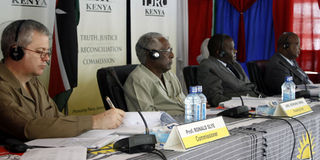DP Ruto misrepresents the Truth Justice and Reconciliation Commission’s report

Truth,Justice and Reconciliation commission(TJRC) commissioners from left, Professor Nonald Slye, Berhanu Dinka, Professor Tom Ojienda and Ahmed Sheikh Farah listening to members of the public testify at Kakamega Social Hall during the sitting
PHOTO | ISAAC WALE | NATION MEDIA GROUP
Does the TJRC report require Kenyans to move back to their ancestral lands?
“….Our competitors are saying that the land issue’s solution is through having the TJRC case to be asked in your place, in their place, in our place. I want to ask you people of Kilifi, if we go down that path of your place, our place and their place, won’t that divide us Kenyans?... Matters of TJRC, where they’d do cases against Kenyans, why you are a Giriama, why you are Kamba, why you belong to this religion. Do you want cases or do you want us to solve the squatters’ issue so that every Kenyan can be issued a title deed?...”
The Truth Justice and Reconciliation Commission originated from the National Accord signed between Mwai Kibaki and Raila Odinga on February 1, 2008, in order to end the violence that tore the country apart after the disputed elections of 2007.
On 14 February 2008, the two parties to the National Dialogue and Reconciliation, ODM and PNU, signed Agenda Item Three, which laid out steps on solving the political crisis. The agreement stated that it was necessary to set up a truth and reconciliation commission and identify and prosecute the perpetrators of the violence, among other vital steps.
On May 23, 2008, the two parties signed the Statement of Principles on Long-term Issues and Solutions, which called for the operationalisation of the Truth and Justice Reconciliation Commission, among other vital steps.
The implementation matrix for that agreement was known as Agenda Item Four. William Ruto, who is now, Deputy President, signed both agreements as part of the ODM delegation.
Flowing from this process, the government enacted the Truth Justice and Reconciliation Act 2008, which came into force on March 17, 2009. The commission was sworn into office on August 3 that year.
POLITICAL ASSASSINATIONS
The report detailed injustices, human rights violations and massacres from the British colonial era, the Kenyatta Government, the Moi government and the Kibaki government.
Particular events included punitive expeditions by the British, the Mau Mau war, the Shifta War, the Wagalla Massacre, the Turbi and Bubisa massacres, the Murkutwa and Lotirir massacres, political assassinations, torture, displacement of minority groups in politically motivated violence, among other human rights violations.
The report also outlined the steps to be taken for reconciliation. These include acknowledgment and apologies to the survivors of injustices, reparations and compensation to those who were dispossessed, release of relevant documents and investigation of suspected perpetrators. The commission also recommended the creation of memorials at the sites of massacres, the resettlement of displaced people and the demarcation of all public land
The Deputy President suggests implementing the report would lead to ethnic minorities being asked to return to their ancestral lands, as opposed to being able to live anywhere in Kenya they wish.
However, the intent of the report, which is different, is to require that anyone who is dispossessed receives reparations for their losses, that justice is served for human rights violations, and reforms are instituted to ensure that abuses are not repeated and Kenyans are reconciled.





